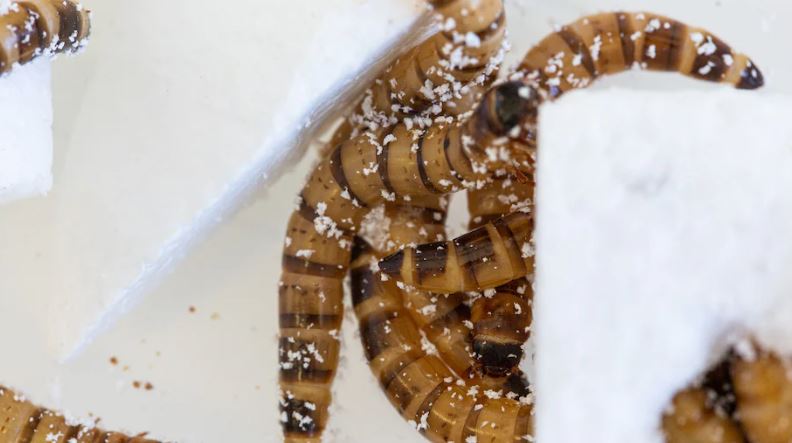Scientists across the world are trying to find bacteria and bugs that consume trash. A plastic-consuming worm is the latest.
In a paper released last week in the journal of Microbial Genomics, scientists from the University of Queensland in Brisbane, Australia, showed that the larvae of a darkling beetle, called zophobas morio, can survive solely on polystyrene, commonly called Styrofoam.
The findings come amid a flurry of research on ways bacteria and other organisms can consume plastic materials, like Styrofoam and drinking bottles.
Now, the researchers will study the enzymes that allow the superworm to digest Styrofoam, as they look to find a way to transform the finding into a commercial product. Industrial adoption offers a tantalizing scenario for waste managers: A natural way to dispose and recycle the Styrofoam trash that accounts for as much as 30 percent of landfill space worldwide.
“You cannot really escape plastic anymore — plastic waste is everywhere,” said Christian Rinke, the study’s co-author. “This is definitely a new, arguably, better, environmentally friendly way to break [it] down.”
The world is facing a plastic crisis. Each year, half of all plastic designed for single use — things like bottles, Styrofoam cups and shopping bags — become trash, clogging up landfills and decomposing slowly while releasing noxious greenhouse gases, according to the U.N. Environment Program. More than 14 million tons end up in the water every year, data shows, killing animals and degrading underwater habitats.
Among plastics, Styrofoam is particularly troublesome. The material is dense and takes up a lot of space, making it expensive to store at waste management facilities, industry experts said. The cups, plates and other materials made from it are also often contaminated with food and drink, making it hard to recycle. Polystyrene fills landfills, where it can often take 500 years to break down and decompose, researchers have found.
As the garbage crisis escalates, scientists across the world are trying to find bacteria and other living organisms that naturally dispose of plastic waste.
In 2015, researchers from Stanford University revealed that mealworms could also survive on Styrofoam. The next year, Japanese scientists found bacteria that could eat plastic bottles. In April, researchers from the University of Texas found an enzyme which could digest polyethylene terephthalate, a plastic resin found in clothes, liquid and food containers.
He said many researchers in this field, including the ones from Australia, will face several challenges in the years ahead. It will take time to study the gut enzymes of things like mealworms and superworms, and when they do, it is not guaranteed they can digest plastics at large levels at a very quick and efficient rate.
Rinke said he was excited by his research results but noted it will take time to develop into an industrial solution, estimating somewhere between five to 10 years.
To conduct the study, his research team in Australia fed the superworms three separate diets. One group was given a “healthy” solution of bran. The second was given polystyrene. The third was put on a starvation diet.
Next, the scientists will study those enzymes to see how well they can digest polystyrene on a large scale — modifying them if necessary to become more effective. “We want to not have gigantic superworm farms,” he said. “Rather, we want to focus on the enzyme.”
If the research proves successful, Rinke said waste managers could collect and grind Styrofoam materials and put them into a liquid solution made with the superworm enzyme. The solution would ideally dispose of the Styrofoam or digest it in a way that allows new plastic products to be created, thereby reducing the need for new plastic materials, Rinke said.
Despite the findings from Rinke and others, there are reasons that none have successfully translated into industry applications over the past decade, researchers said. Andrew Ellington, a professor of molecular biosciences at the University of Texas at Austin, said it has been difficult to find a plastic-digesting organism or enzyme that can operate in industrial conditions, which often process trash in very hot environments or through the use of organic solvents.
“When you find something on a beach or you find something in a worm gut, that’s great, but all the enzymes in that thing work pretty much under the conditions where you found it,” he said. “And those may not be industrial conditions.”
“I believe that we will be able to offer up, in the not-so-distant future, worm-based composting kits so that individuals can do this themselves,” he said.
Jeremy O’Brien, the director of applied research at the Solid Waste Association of North America, said there are other business challenges in putting this type of solution into use.
As envisioned, the solution would require waste managers to collect Styrofoam separately from other trash, he said, which makes it cost-prohibitive.




